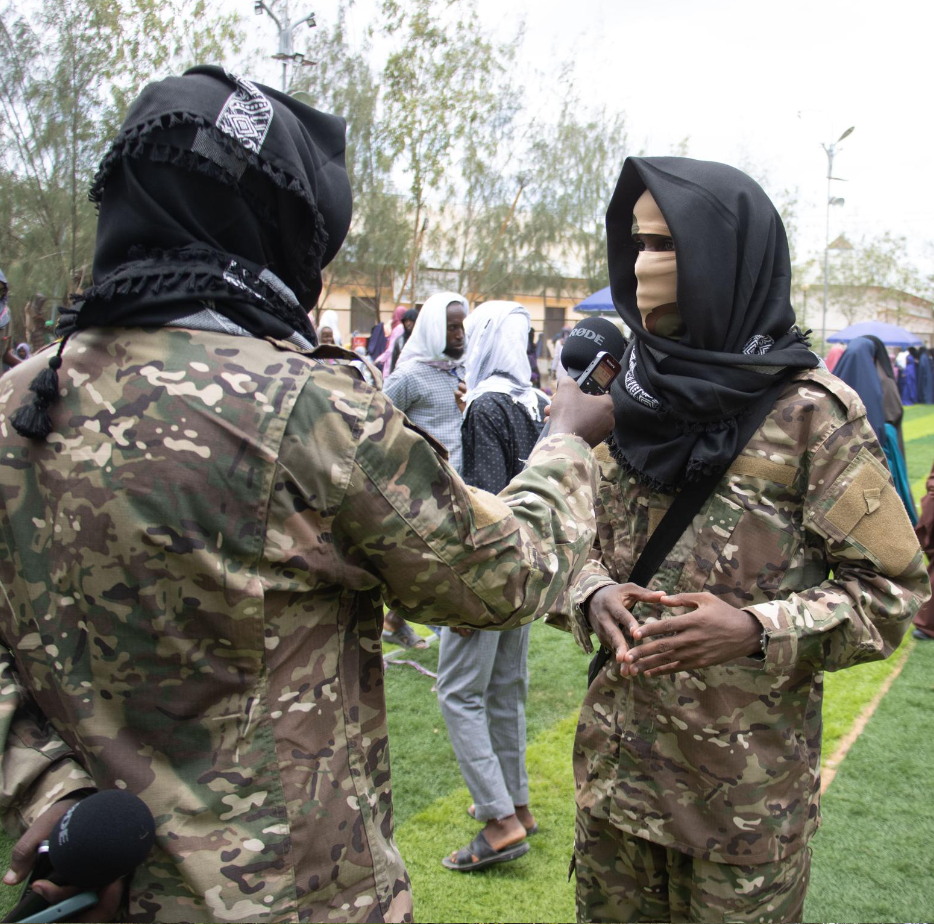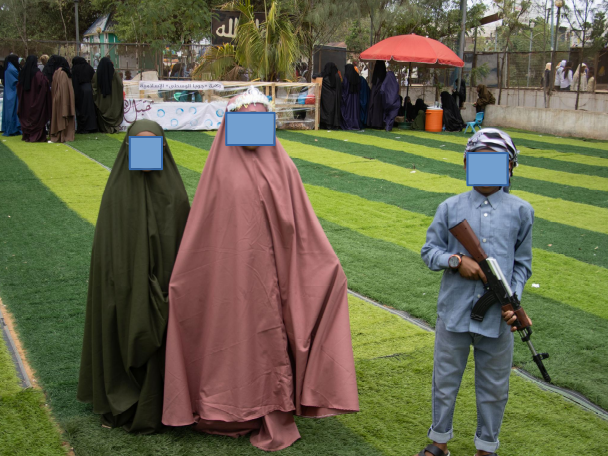Authored by Cara Rau, Intelligence Analyst specialising in African Jihadism and Political Violence
Bottom Line Up Front
Al Shabaab has one of the most sophisticated, organised, and effective propaganda machines of all Jihadist groups. The group runs multiple news outlets across various platforms in multiple languages in order to both share news with their online supporters and to recruit new members. This report looks into recent activity by the group's producer of audio and visual content, Al Kataib Media Foundation and the Shahada News Agency, which is one of the most prolific online news sites to distribute Al Kataib content. Let us examine recent trends in content from the two sources to gain a deeper understanding of the ever-evolving media landscape of one of the most prominent Jihadist groups in Africa.
 |
| Al Shabaab Fighters. Source: Al Kataib Media Foundation |
Al Kataib Media Foundation
Al Kataib Media Foundation regularly shares content about the group's military operations alongside images and videos from the battlefield. The Foundation also frequently publishes content that aims to legitimise the group's actions in the eyes of their supporters and opponents alike, framing their actions in defence of Islam from the apostates and the Western world who seek its destruction.
Recent Themes
A notable
new theme from Al Kataib's content is the
denunciation of Ethiopian air strikes in Somalia's Middle Shabelle, Lower Shabelle and Middle Juba Regions which Shabaab said killed civilians, including women, children and the elderly, and destroyed a large amount of property. The group released the names of those it says were killed in the strikes which the
Somalian Minister of Defence said targeted Al Shabaab strongholds. Notably, the statement by Shabaab condemning the strikes highlighted that the Somali government is using the aircraft of the "Ethiopian Crusaders" (who Shabaab says are the traditional enemies of the Somali people), to massacre the people of Somalia and destroy their property. As usual, Shabaab called on all Somali Muslims to
take up arms to defend themselves from the "infidel alliance of the crusaders and apostates, especially the youth, who have a duty to defend their religion, country and people." It is clear that Shabaab is using Al Kataib to
recruit new members from the Muslim population of Somalia who have suffered at the hands of the Somali government. The
recruitment of youths who suffer as a direct result of government actions is a common tactic by Jihadist groups in Africa and this factor should be taken into account by counter-radicalisation programs on the continent.
 |
| Screenshot from an Al Shabaab video allegedly showing the aftermath of an Ethiopian air strike in Jilib, Middle Juba Region. Source: Al Kataib Media Foundation. The video also featured witness testimonies from civilians affected by the strikes. |
Al Shabaab's seizure of the strategic town of Masajid Ali Gadud in Middle Shabelle Region on 26 March 2025 was a prominent feature of Al Kataib's recent content. Al Kataib shared numerous images of soldiers taken captive and those killed as a result of the operation alongside weaponry seized by the group in the aftermath. There were also multiple short statements giving vague details of the operation. For example, one statement said that the group carried out a "multi-directional attack" which led to the capture of the town.
 |
| Image of the attack on Masajid Ali Gadud, Middle Shabelle Region. Source: Al Kataib Media Foundation |
Besides reporting on Shabaab activity, Al Kataib frequently reports on other conflict and news in the region. On 27 March 2025, the agency reported on fighting between
Fano and the Ethiopian government forces in the restive Amhara Region where they highlighted civilian casualties in the fighting. Notably, Al Kataib referred to Fano as the "Amhara Liberation Front", which is not the official name of any group in Ethiopia, though
some users on social media have referred to Fano this way. This is possibly Shabaab's subtle way of framing Fano as a liberating force which has come to free the Amhara region from the oppressive government forces, similar to how Shabaab frames their own actions in Somalia.
A 29 March 2025 report by Al Kataib focussed on a 28 March 2025 news report by
Semafor. The Semafor report said that Somalia’s government has offered the US “exclusive operational control” over strategic ports on the Gulf of Aden in a bid to derail any recognition by Washington of breakaway regions in Somalia. The Al Kataib report said nothing notable, other than calling both the Somaliland and Somalia administrations apostates. It also briefly highlighted that the Semafor report comes amid reports that the Trump administration is planning to recognise Somaliland.
Another post by Al Kataib reported on the
house arrest of South Sudan’s vice president, Riek Machar, reporting the story in a neutral tone akin to that of a reputable news agency. Al Kataib's reporting on regional politics is likely a reflection of the outlet's intentions to frame itself as a reliable news agency so that when they do report on Shabaab activity, they are more likely to be viewed as a legitimate source of information.
Shahada News Agency
Shahada News Agency is one of the main news outlets that spreads Al Kataib content online. It frequently publishes imagery from the battlefield and claims of credit for attacks in Somalia, Kenya and Ethiopia alongside speeches from Shabaab leaders and news stories from the region and globally.
Recent Themes
On this year's Eid al Fitr, Shahada shared footage from the Sheikh Bashir Sheikh Yusuf training camp. The video showed the latest batch of Shabaab recruits performing well-drilled military exercises as well as a speech Sheikh Bashir Sheikh Yusuf, who explains why the camp is named after him. The video goes on to highlight what Shabaab calls the undeniable legacy of struggle and jihad in Somalia, specifically referring to victories in battles against the British occupation.
 |
| Images from the Sheikh Bashir Sheikh Yusuf training camp |
in an unknown location. Source: Al Kataib Media through Shahada News Agency
Another notable theme from Shahada is the framing of what appears to be child soldier recruitment as an exhibition of local life in Somalia. On Eid al Fitr, Shahada released a photo set and a statement from Jilib, Middle Juba Region which Shabaab said showed "an exhibition of local crafts". According to the group, the exhibition provided an opportunity for traders to showcase their products and ideas and introduce residents to various industries that connect them to the region's history, extending to the present. Shabaab also said that the exhibition was accompanied by activities to entertain children during Eid, including dedicated spaces for play and competitions. However, the accompanying photos, which did indeed appear to show a crafts exhibition, also showed boys holding both toy guns and real weapons. Regardless of whether the guns are real or not, Al Shabaab sharing imagery of children holding guns is almost certainly evidence of the group using this craft exhibition to recruit children. Many women were also present at the exhibition, sitting behind booths showcasing their crafts. Additionally, despite them being unarmed, the presence of girls in the photos is also concerning and overall, the images highlight the urgent need for intervention to stem child recruitment into Al Shabaab in Jilib. While boys are recruited as fighters, girls are usually recruited as wives to these fighters. Some Al Shabaab fighters were also present in some of the images.
 |
| Images showing child recruits into Al Shabaab, women selling their crafts, and Al Shabaab fighters in Jilib, Middle Juba Region. Source: Shahada News Agency |
Finally, in terms of recent political developments reported by Shahada, the group published what appears to be a translated version of the
BBC report of claims by Burundi's president that Rwanda plans to attack his country. Other stories included the
US list of conditions for partial sanctions relief for Syria and the
house arrest of the vice president of South Sudan. All of these stories were reported in a neutral tone, similar to how Al Kataib reports news stories that are not connected to direct Al Shabaab activity.
Conclusion
While this piece does not mention every single publication by Al Shabaab in recent times, it does highlight significant themes which have featured in recent Shabaab publications. What we can learn from their recent propaganda content is that the group is still far from being defeated as is evidenced by the new batch of graduates from the training camp and the takeover of Masajid Ali Gadud town. Further, it remains clear that the group continues to recruit children and from the crafts exhibition imagery, it is evident that in some places Al Shabaab can operate in broad daylight among the civilian population without fear of kill or capture. Finally, both Shahada and Al Kataib are thriving online and their online presences highlight the need for counter-radicalisation strategies that can effectively address the problem of online recruitment into Jihadist groups.














Comments
Post a Comment